If you're new here, you may want to subscribe to my RSS feed. Thanks for visiting!
By Daisy Luther
Do you have a source of delicious, creamy raw milk? Or, as our grandparents used to call it, milk?
If you do, you probably cringe when you have to go to the store and purchase dairy products from pasteurized milk. Well, cringe no more, because it is unbelievably easy to make your own homemade dairy products, like cottage cheese and sour cream. And by “unbelievably easy” I mean that you pour milk into a bowl, cover it with a towel, and leave it on the counter for 2 or 3 days. I couldn’t make this stuff up – it’s that easy. Well, there are a couple of finishing steps to perfect your product, but that’s how you make these things.
If you tried this with store-bought milk, you’d have a disgusting, smelly mess on your hands that you couldn’t choke down without gagging. This highlights the real difference between raw milk and pasteurized. Raw milk is alive, teeming with healthy gut bacteria, while pasteurized milk is dead, and will rot and degrade if not refrigerated. And yet, somehow, farm fresh milk is contraband equivalent to heroin or cocaine in some states.
The sour cream you get from this process is what really got me thinking about raw milk products. Have you ever wondered why there are so many chemicals in the sour cream you get from the store? That’s because it’s not real. Real sour cream is just that, cream that has soured. Because store-bought products must be pasteurized, it is impossible to make real sour cream. You’d just have rotten cream.
Let that sink in for a minute. Very few people in America have actually had sour cream! They only think they have, but it’s an artificial concoction.
Once you indulge in the richness of the homemade raw milk product, you’ll never want to eat the stuff in the plastic tub again. And when you see how easy it is, you’re going to say, “You’ve got to be kidding!” Nope. It’s this easy.
If you’re into preparedness, it’s important to note that this is a great, off-grid way to extend the longevity of any raw milk you happen to have in your fridge in the event of a power outage.
IMPORTANT: If you are making cottage cheese from store bought, pasteurized milk, follow the instructions here. If you try to follow this process it won’t work. At all.
Supplies for making raw milk products
Okay, let’s get started. Here’s what you need.
1.) A bowl
2.) A Flour Sack Towel (You’ll use this again later.)
3.) Raw milk
Make sure your bowl is very clean. You don’t want to grow anything funky in there.
You can use raw milk that has begun to taste a bit off for this. I always use whatever I have left when it’s herd share day. There’s no set amount required. If you use a quart of raw milk, you will get about half a cup to a cup of cottage cheese. The amount of sour cream depends upon the amount of cream in your milk. If you’ve been pouring right off the top and not shaking up your raw milk, you won’t get a lot of sour cream. However, if you put some cream aside right away, you’ll get lots of rich goodness from this process.
I like to use flour sack towels for most things in the kitchen because they’re lint-free and versatile. They can be used for anything from hanging cheese to pectin-free jam making to, of course, drying stuff. These are the ones I buy. I always wash them a couple of times before I use them for food making.
Allow the milk to sour on the counter.
I feel like I should be making this seem more complicated than, pour the milk into the bowl and cover it up. But that’s literally ALL YOU DO in this step. I keep my bowl in the laundry room because it’s a few degrees warmer than the kitchen.
Skim the sour cream that rises to the top.
Leave it overnight. On the morning of the second day, taste the creamy goodness on the top, If it is not quite tart enough, leave it to sour for a few more hours. If it’s just how you like it, skim that sour cream off the top and put it in the fridge. Depending on the texture you prefer, you may wish to drain the sour cream using a flour sack towel to thicken it up. (Then make some potatoes so you can eat it all.)
Let the milk separate.
You want to leave it for 2-3 days until it separates completely into something that resembles the contents of the bowl in the photo above. Yuck, right? That, my friends, is a bowl of curds and whey. (I can’t even tell you how much I want to make a Little Miss Muffet joke right now.) I really like to put pretty pictures on my website, but you need to see this so you know that it’s actually supposed to look like that. When it does, you’re ready to move on to the next step.
Drain the whey from the curds.
Use your flour sack towel to line a colander. Place the colander over a bowl to catch the whey (see below for “wheys” to use it – haha.)
Leave it on the counter to drain for a couple of hours, or until it is the consistency you desire. Pour the whey you’ve collected into jar and put it in the fridge.
Rinse the curds.
Gather it up in the flour sack towel and put it under the running tap to rinse the whey off of the curds. If you don’t do this, it could have bitter flavor that some people find unpleasant. Squeeze the water out. Return it to the colander and let it drain for another hour.
And you have homemade cottage cheese!
Isn’t that gorgeous? It won’t have the hard uniform curds of grocery store cottage cheese. It will be light and fluffy in texture.
What you can do with whey:
- Substitute for water or milk in baking
- Use in place of part or all of the water when cooking rice or pasta
- Use it for smoothies
- Use it in oatmeal or other porridge
- Feed it to livestock for some yummy probiotics – dogs and chickens love it
- Make ricotta cheese
- Use it for lacto-fermentation
Some recommended reading:
The Home Creamery: Make Your Own Fresh Dairy Products; Easy Recipes for Butter, Yogurt, Sour Cream, Creme Fraiche, Cream Cheese, Ricotta, and More! (You have to have this book. If you have access to fresh milk, this will be life-changing!)
Wild Fermentation: The Flavor, Nutrition, and Craft of Live-Culture Foods
The Raw Milk Revolution: Behind America’s Emerging Battle over Food Rights

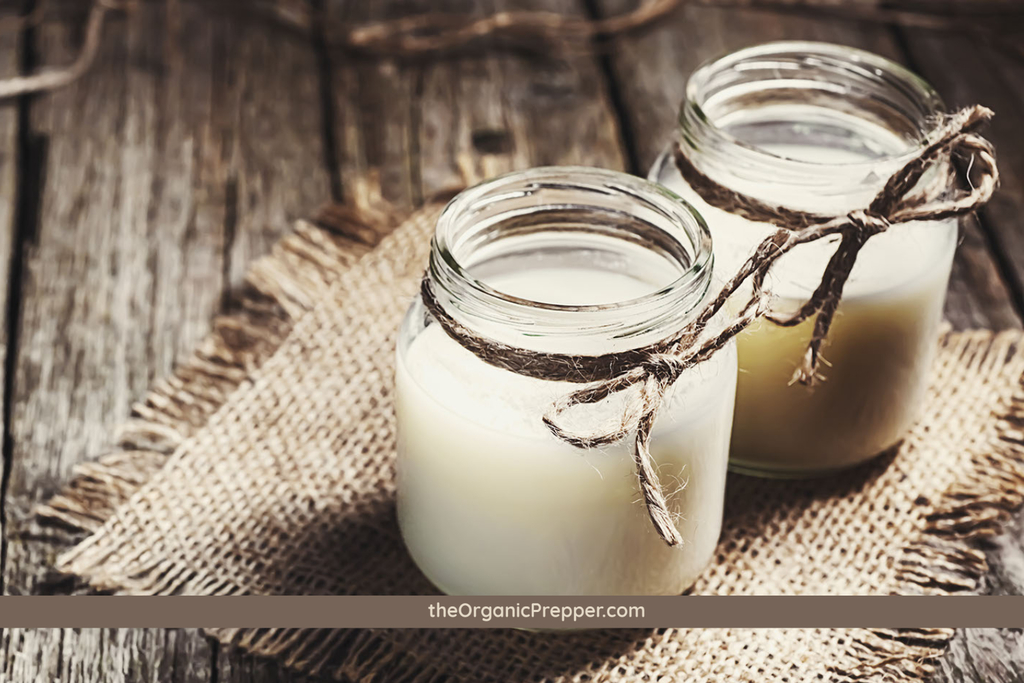
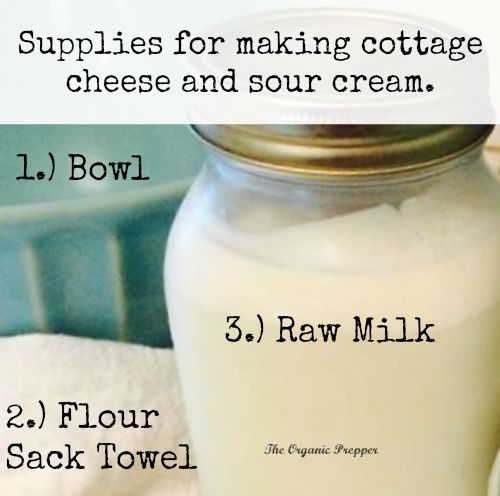
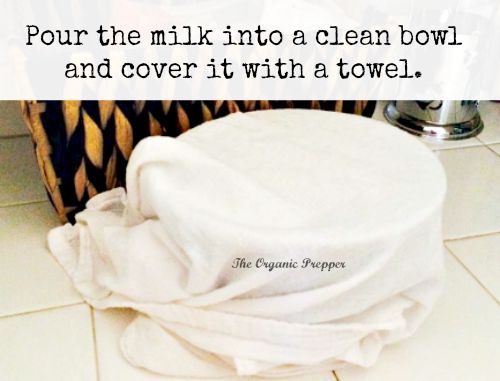
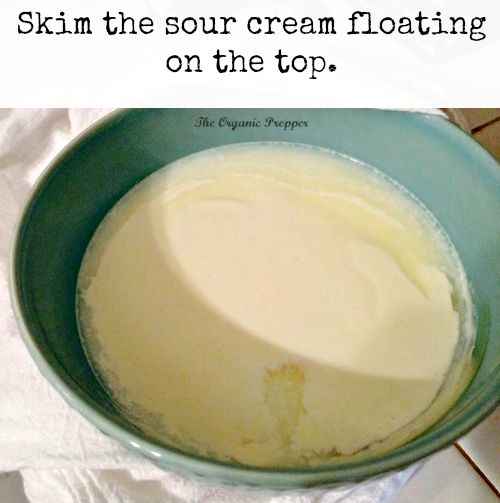
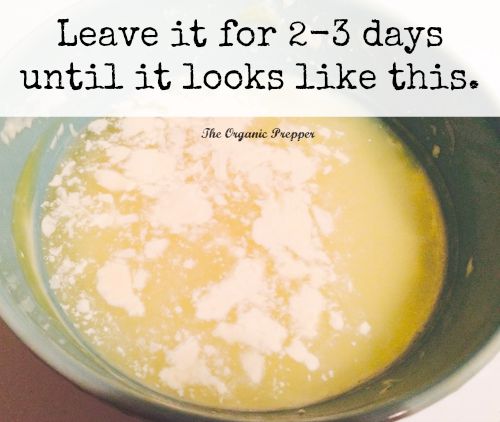
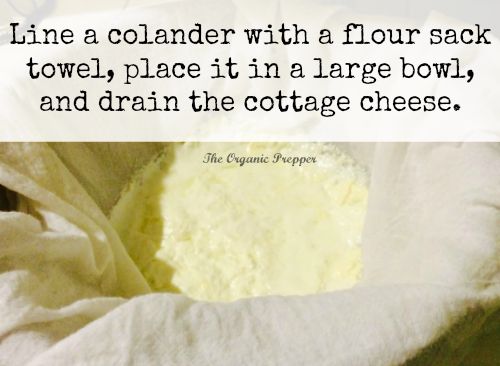
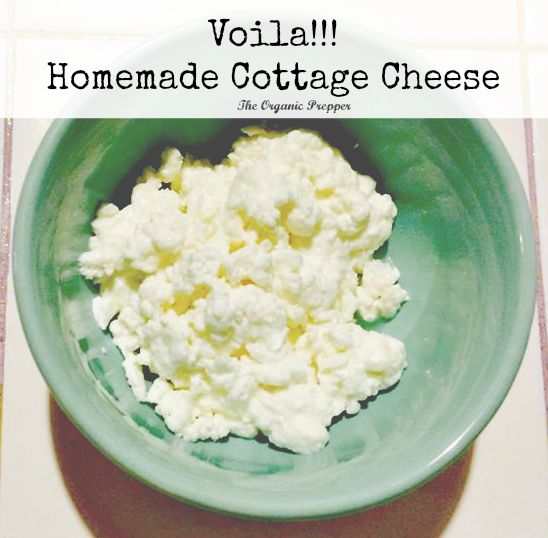















This sounds yummy & delicious. Is this recipe in your cookbook?
Hi! No, the cookbook is just canning recipes. 🙂 Maybe the next one?
It’s very good. This afternoon I mixed some honey and cinnamon in with the cottage cheese and topped it with fresh peaches. Mmmm….
Thank you Daisy…. I have used this method with good success. Have you made raw goat milk cottage cheese? I am more fond of raw cow milk cottage cheese but I have easy access to all the raw sweet goat milk I can use.
Not yet, but I am getting goats soon so I’ll report back. 😉
If I wanted to add salt when would you add it? After the cream is removed? Can’t wait to try this!
I add the salt after rinsing the curds. 🙂
Great recipe. I have extra raw milk this week from my cow share…so I will do this. Can you tell me how long whey keeps? Does it need to be refrigerated? Thanks so much.
I refrigerate my whey but go through it fairly quickly – my animals love it. I have no idea how long it would keep, since it’s usually gone as soon as I have it. I’d say maybe a few days at the most.
Whey will last 6 months in your fridge. I use it in a lot of things. 🙂
Oh thanks 🙂 I had no idea it would last this long. Can you share the things you use it for, Kansas? Always looking for new whey ideas!
Is this the same thing as Milk Kefir? I have kefir that I make, let sit and strain it out and make smoothies and then reuse the grains or give them away, and this looks just like the grains.
No – milk kefir requires kefir grains, and it’s a bit different. But oh-so-delicious! 🙂
Daisy! Help! I use raw milk, and tried three times to make cottage cheese, but i end up with a floating pancake after two days. What am I doing wrong? (I do skim the cream for my breakfast before pouring the remainder into the bowl and covering with a towel)
Rick
This same thing happened to me. I had to leave my original raw milk out for an extra day before there was enough sour cream to skim off… didn’t think that would hurt. Then I replaced my cloth over the bowl and put it on top of my fridge. Left the concoction there for about 2 days more, maybe three… when i removed the cloth there was a floating “pancake’ – kinda looked like a Kombucha scoby.
However, I went ahead and used two wooden stirs to lift it up and out and placed it into a stainless steel bowl… I then poured the whey from the original bowl into a mason jar through a fine mesh strainer… I dumped the few curds from that back into the bowl with the curd pancake…
I then took a fork and started gently breaking the pancake down… I then poured off more whey. Then I poured the broken up curds into the fine mesh strainer and held it under the kitchen faucet and rinsed the whey off as I “rolled” the curds by bouncing them in the strainer… I believe this really washed any whey off… I then placed the strainer over the stainless bowl and let it drip dry for quiet a while… I tasted a bite of it and it was not bitter (needed a bit of salt) but I am certain the floating pancake method is a winning option. In fact, if it winds up not spoiled by doing it this way, I’m happy for it to do it every single time as fishing it out makes it easy to remove the whey…
Just for clarification, I use raw milk I get from my raw milk club… it is full of cream! Love making butter and now cottage cheese. Will go for Ricotta next from the whey…
Hi I just made the cottage cheese and I rinsed it well but it tastes very bitter. What’s the matter? I there something I can do yet to make it eatable?
Generally when this happens, it’s because there’s too much whey in it still. Salt the cheese and put it in a cheesecloth or flour sack towel and tight it up tightly. You are working to squeeze out more of the whey. Put this on a sieve over a container to catch the whey. You can put something on top of your cheese cloth bundle to try and press more whey out of the cheese. I hope this helps 🙂
Dear Daisy, I am A retired fighter pilot employed at Dreamworld Resort Karachi where we also have a cattle farm and lots of milking cows. I am going to try your recipe for making cottage cheese for our members. Will give you the report on results
I have skim milk. When it begins to taste like it maybe is souring what can I use it for?
If it is pasteurized, you might be able to use it for baking, but if it’s very far gone, you should throw it out.
If my milk has already started to curdle can I still use it to make cottage cheese?
If it’s raw milk, you should be fine. You’ll want to rinse the curds well. 🙂
Hello! I am wondering how long the cottage cheese will stay good after making? Thank you!!
I’d say a few days. Since it has no preservatives, it won’t be good sitting in the fridge for a month. 🙂
So I left the raw milk on the counter for many upon many days… And when I finally scooped the sour cream off the top it did have some mold… Do you happen to know if this is a result of keeping it out too long or more likely the bowl wasn’t as clean as it needed to be?
You let it sit too long, a flour sack towel doesn’t have small enough holes to prevent spores going through. If your finding your having issues getting things going with this method you can purchase starter cultures of the good bacteria it significantly shortens the process if you can find a mother culture you can keep it going for months and remove some as needed for your needs, those liquid live cultures are expensive and can take a lot to keep going BUT I have found them to be of great value some strains can even be used for multiple different products.
Thank you so much for this information! I got some milk from my neighbor (and his cows), and there was too much to use right away. I had an idea that it would sour and separate into curds and whey, but it didn’t. Now I know why. I kept it in sealed bottles, so no more air could get in. I ended up accidentally making milk bombs, because the milk exploded out when I opened the bottles! Yuck. Not yummy cream cheese at all. Next time I’ll try your method. My neighbor has lots of cows…
How much kcal is in 100g of this cheese?
I’m sorry – I have no idea!
I like the saltiness of cottage cheese. Does this happen naturally or do you need to add it?
Thank you for your article and I love your humor!!!
You’re very welcome, and thank YOU for the kind words. 🙂 You need to add salt to this.
I just tried this, but it was on the counter for 5 days before it curdled. It smells pretty sour. Was it a bust?
Is raw milk safe to use without heating?
When we had a good source of raw milk, we used a gallon of it per week without heating.
Can you strain this in a mesh bag instead of a towle?
Sure, as long as the mesh is tightly woven enough. 🙂
I’m trying this for the first time! I’m hoping for cottage cheese, do I still need to skim off the sour cream or do I leave it then?
I always skim it off 🙂